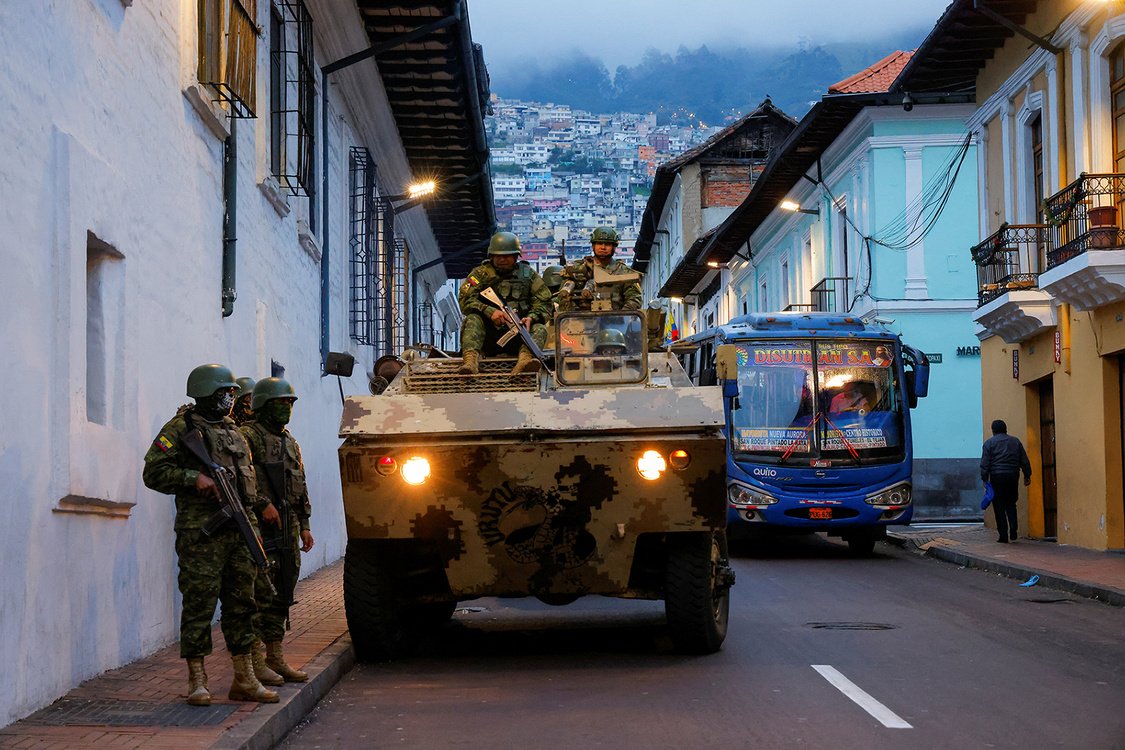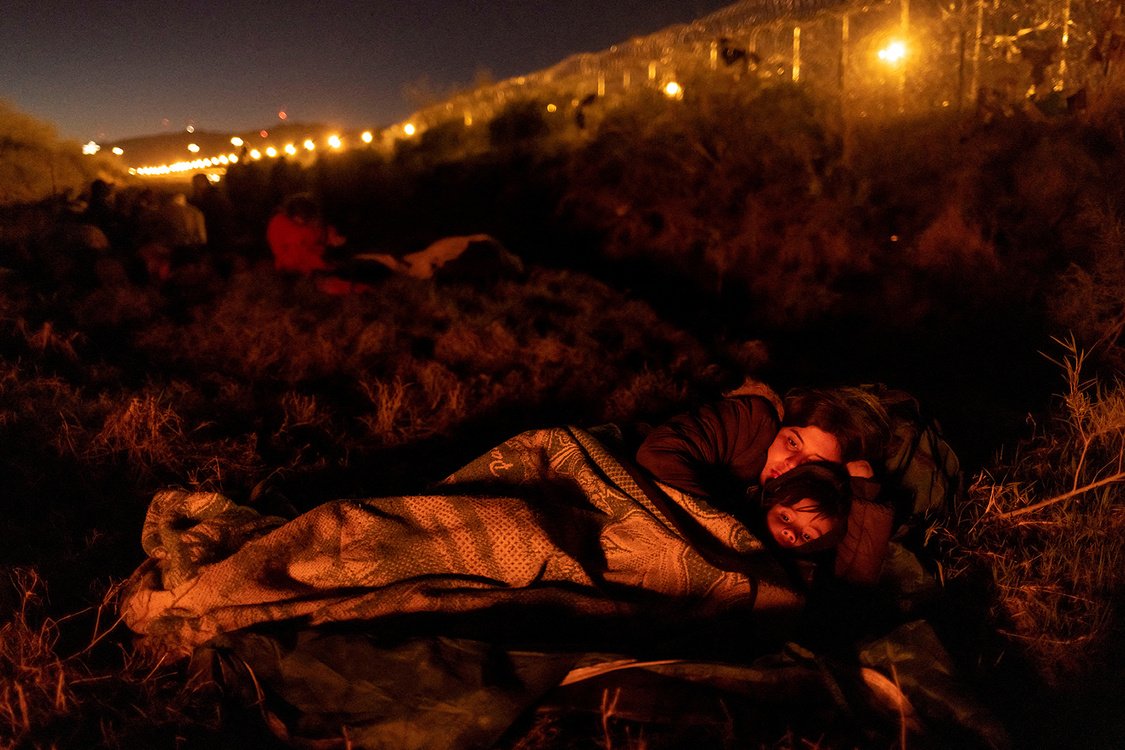Why Six Countries Account for Most Migrants at the U.S.-Mexico Border
Migrants and displaced people from across the world are arriving at the U.S.-Mexico border in droves. More than half come from six Latin American countries, where worsening violence, poverty, and other factors are pushing them to leave.
The dynamics and scale of migration in and throughout the Americas have changed since the COVID-19 pandemic. Millions of migrants and displaced people are arriving every year to the U.S.-Mexico border, hailing not just from Mexico and northern Central America, but also from countries further south and from across the globe.
Migration on an Unprecedented Scale
U.S. Customs and Border Protection (CBP) registered close to 2.5 million migrant encounters at the southern U.S. border in fiscal year 2023. Such high levels of migration are increasingly putting pressure on border infrastructure and personnel, contributing to a humanitarian crisis, and inflaming domestic political debate on the future of U.S. asylum, border, and immigration policy.

So far, in 2024, encounter numbers have decreased overall, but they remain high for certain countries. In the first five months of the year, CBP agents encountered more than nine hundred thousand migrants and asylum seekers at the U.S.-Mexico border. The majority hailed from just six countries: Mexico, Guatemala, Venezuela, Cuba, Ecuador, and Colombia, in descending order.
The Joe Biden administration has responded by designing policies to mitigate “root causes” of migration and displacement, enacting temporary humanitarian protections for individuals from certain countries, while making it more difficult for migrants to apply for asylum in the United States. But push factors—including organized crime-fueled violence and extortion and a lack of economic opportunities—combined with the pull of a strong U.S. labor market, make it unlikely migration flows will decrease substantially in the near future.
When taking a closer look at the conditions driving people to leave these six countries, it’s clear why the challenge of managing large-scale migration and displacement is seemingly here to stay.
Mexiko
Mexicans have migrated to the United States in large numbers for decades. Despite a decline in numbers during the 2010s, CBP encounters with Mexicans at the U.S. southern border are rising again. While Mexicans previously migrated mostly to seek out economic opportunities—and most of the migrants were young men traveling alone—recently, the share of Mexican families migrating has increased. Many are fleeing states in southern Mexico, such as Guerrero, Chiapas, and Oaxaca, that have been hit hard by intracommunal and criminal violence and extortion.

A 2022 UN International Organization for Migration survey found that 90 percent of Mexican migrants left the country due to violence, extortion, or organized crime. The United States and Mexico have historically cooperated on countering organized crime, but during the six-year term of outgoing Mexican President Andrés Manuel López Obrador, Mexico’s federal government often took a hands-off approach to cartels and gangs, allowing them to expand their territorial presence. Meanwhile, bilateral security cooperation has faltered.
Mexico could be positioned to revise its approach as President-Elect Claudia Sheinbaum takes office in October. If she develops a new and more effective strategy to curb organized crime and convinces governors of southern states to work with her, Mexico’s migration and displacement numbers could once again begin to decline. But if the south’s security crisis persists, migration from Mexico is expected to continue, if not grow.
Guatemala
Extortion by gangs, poverty, and the effects of worsening climate change on farmers are all driving displacement in Guatemala and fueling migration. Most Guatemalan migrants come from the departments of Guatemala, San Marcos, and Quiché. The department of Guatemala, which includes the capital, has the fourth-highest homicide rate in the country and is an extortion hot spot. San Marcos and Quiché face widespread poverty and struggle to attract commercial activity and investment.

Rising gang and cartel violence along Guatemala’s border with Mexico has also displaced locals. Meanwhile, climate change is taking a toll on subsistence farmers in a region known as the “dry corridor,” pushing many from this part of the country to head north.
The Biden administration has pledged $170 million in development assistance to Guatemala since President Bernardo Arévalo—an anticorruption reformer—took office in January. Arévalo recently rolled out a cash transfer program that provides assistance to one hundred thousand families in impoverished parts of the country to slow emigration. Arévalo has also launched a crackdown on extortion. If successful, migration and displacement from Guatemala could slow during his term, but they will not likely experience a major decline. Managing the consequences of climate change and decreasing the poverty rate will take years, if not decades.
Venezuela
Since 2014, nearly eight million Venezuelans have left their homes, fleeing an economic crisis and authoritarian repression under President Nicolás Maduro. Of all Venezuelan migrants surveyed in a 2022 poll by Centro de Investigaciones Populares, 72 percent said economic problems, including hyperinflation, poverty, and food insecurity, pushed them to migrate.

Violence and abuse by security forces have also forced Venezuelans to flee. The country remains one of the most violent in the region, despite the homicide rate dropping last year.
In the first four months of 2024, tens of thousands of Venezuelans left the country, accounting for 64 percent of all migrants who have so far crossed Panama’s Darién Gap. The exodus of Venezuelans will likely accelerate if Maduro secures another six-term year in elections scheduled for July 28, which almost certainly won’t be free or fair.
Cuba
Cubans are also fleeing a broken economy and authoritarian repression. Last year, Cuba’s economy shrunk by 2 percent, leaving it as much as 10 percent smaller than in 2019, and in its worst state in more than three decades. The island’s inflation rate is one of the highest in the region and wages have stagnated, while food and fuel prices have shot up in recent years. Shortages of food and medicine have placed added pressure on Cubans to leave.
Today, Cubans are opting to head to the southern U.S. border via overland routes because of slow processing times for U.S. humanitarian parole programs and the availability of flights to Nicaragua. Since the Nicaraguan government lifted visa requirements for Cubans in 2021, Cubans have taken as many as fifty flights per month to the Central American country to begin their journey north.
Ecuador
Since 2021, hundreds of thousands of Ecuadorians have fled a surge in drug- and gang-related violence and extortion. Last year, Ecuador had the highest homicide rate in Latin America, with 44.5 homicides per 100,000 people, after previously ranking among the region’s most peaceful countries. The ongoing security crisis has prompted President Daniel Noboa to declare a state of “internal armed conflict”, mobilize the military against gangs, and arrest more than sixteen thousand people since January.

But these policies have not pacified the country. While the national homicide rate has dropped slightly in the first five months of 2024, nine of Ecuador’s twenty-four provinces have seen murders increase compared to last year, and extortions and kidnappings are also on the rise, according to figures from the National Police. Corruption, which has enabled the rise of gangs, has also sapped Ecuadorians’ confidence in the state to protect them.
The United States has agreed to provide more than $100 million in logistical and material support to Ecuador’s security forces to fight gangs and cartels, but progress is likely to be slow if it happens at all. Ecuador has become a strategic transit point for cocaine in South America, and its heavily armed and well-financed gangs will not easily give up control.
Kolumbien
Persistent violence and insecurity stemming from the country’s ongoing internal armed conflict, combined with slow economic growth, are driving tens of thousands of Colombians to migrate and seek asylum in the United States. Colombians also cite the search for better economic opportunities in their decision to leave.

Policies that make it easier for Colombians to travel north may also be contributing to the consistently high numbers. Unlike other nationalities discussed here, Colombians can travel to Mexico visa-free. If they have the money to fly, they can skip the dangerous Darién Gap crossing between Colombia and Panama (although close to twenty thousand Colombians [PDF] still took that route in 2023, according to data from the Panamanian government).
The Need for a Regional Strategy
The Biden administration has responded to this unprecedented displacement in a number of ways. It has expanded the availability of legal migration pathways, establishing a humanitarian parole program for Cubans, Haitians, Nicaraguans, and Venezuelans that allows a combined thirty thousand individuals from these four countries to enter the United States each month. The program reduced CBP migrant encounters with Cubans and Nicaraguans by 88 percent and 77 percent, respectively, in 2023.

The administration has also tightened asylum processes. It raised the standards for “credible fear” interviews (used to gauge whether asylum seekers have a reasonable chance of winning their cases) and enacted a rule that disqualifies broad categories of asylum seekers. Additionally, in June, Biden signed an executive order that suspends migrant entries at the U.S.-Mexico border once the daily number of illegal crossings exceeds a certain threshold. But, like past deterrence-based measures, these policies are unlikely to dramatically slow the pace of new arrivals at the border.

A more promising approach is for the United States to work with its Latin American partners to manage migration flows and mitigate the forces driving displacement. In 2022, the U.S. government and twenty others from across the Western hemisphere signed the Los Angeles Declaration, a first-of-its-kind framework to jointly address the root causes of regional migration, expand available legal pathways, and strengthen border enforcement. The Biden administration also set up new screening centers, known as safe mobility offices, in Colombia, Costa Rica, Ecuador, and Guatemala that allow migrants to apply for asylum from these countries.
The United States can and should do more to support Latin American countries that are absorbing most of the region’s displaced people and migrants. The UN refugee agency estimates that more than twenty-two million people were in transit throughout the hemisphere in 2023; 80 percent of those migrants and displaced people remain within the region. Latin American countries have, in most cases, handled the influx remarkably well, providing migrants access to temporary visas, basic services, and work permits. But they have limited capacity to keep absorbing newcomers.

The United States should work with regional allies, development finance institutions, the private sector, and nonprofits to mobilize the financial resources needed to bolster host communities and countries. Washington and its partners should also seek to deepen security partnerships and train police, prosecutors, and judges to fight extortion. Migration and displacement on an unprecedented scale are testing the governments of the Americas. But managed well, migration could translate into opportunity, boosting labor markets and helping countries meet looming demographic challenges.
Recommended Resources
This photo essay explores the treacherous journey migrants take through Panama’s Darién Gap.
This Backgrounder dives into migration from Central America’s Northern Triangle.
These Backgrounders explain the U.S. asylum and refugee systems.
This CFR Infoguide examines the global migrant crisis and the strains it places on the international refugee system.
At this CFR event, the International Rescue Committee’s David Miliband and the White House’s John Podesta discuss the relationship between climate vulnerability and conflict zones.
Diana Roy edited this article.
 Online Geschäft
Online Geschäft










